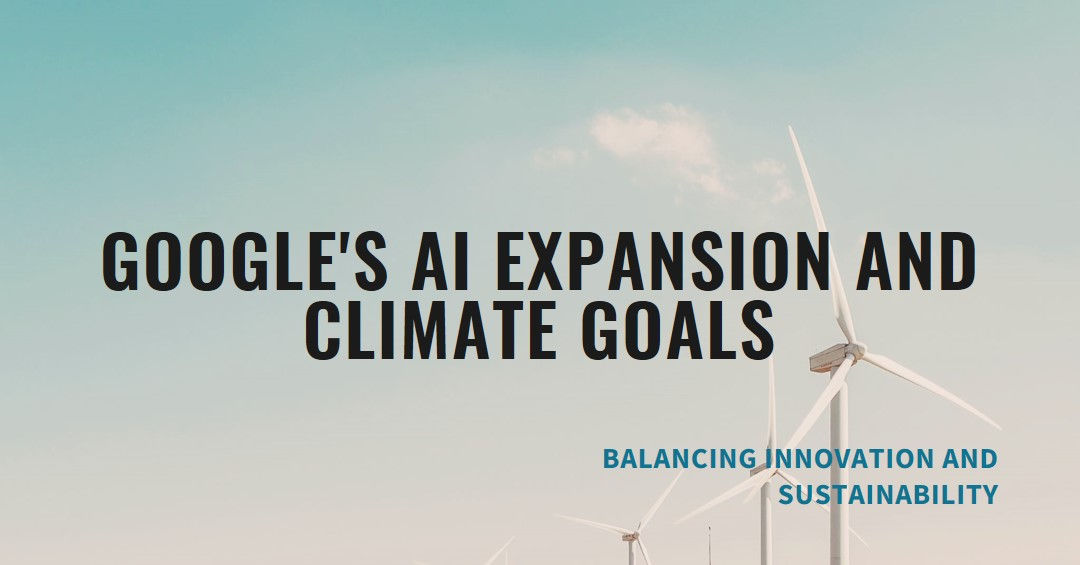Google faces a challenge balancing AI advancement with climate goals. Its 2024 Environmental Report shows a 50% rise in carbon emissions over five years due to AI-powered data centers. Despite aiming for 24/7 carbon-free energy by 2030, AI's energy demands pose obstacles.
Strategies for Sustainability:
The tech industry, including companies like Microsoft and Amazon, must find sustainable solutions to manage AI’s growing energy demands. Google aims to balance AI innovation with environmental stewardship through these efforts.

Google finds itself at a critical juncture, striving to advance its AI capabilities while adhering to its ambitious climate goals. The tech giant's 2024 Environmental Report reveals a 50% surge in carbon emissions over the past five years, driven by the energy demands of AI-powered data centers. Despite pledging to operate on 24/7 carbon-free energy by 2030, the increased energy consumption from AI developments presents a formidable challenge. Google must now innovate in energy-efficient AI models and invest further in renewable energy to reconcile its AI ambitions with sustainability commitments.
The rapid advancement of AI technologies, particularly in deep learning and large language models, necessitates substantial computational power, thereby increasing energy usage. Google's AI applications, including Google Search and Google Assistant, significantly contribute to its carbon footprint. The company’s emissions rose from 9.7 million metric tons of CO2 in 2019 to 14.3 million metric tons in 2023, highlighting the environmental impact of its AI operations.
Google's commitment to sustainability has been a cornerstone of its corporate ethos, with a goal to achieve 24/7 carbon-free energy by 2030. However, the increasing energy demands of AI present a paradox: the very technologies that drive innovation also threaten environmental sustainability. Google's case is emblematic of a broader industry challenge faced by tech giants like Microsoft and Amazon, which also struggle to balance AI advancements with environmental responsibilities.
To address this dilemma, Google must intensify efforts in several key areas:
Energy-Efficient AI Models: Development of more efficient AI models and advancements in AI chip design, such as Google’s Tensor Processing Units (TPUs), are crucial. Research into low-power AI and quantum computing could also offer significant breakthroughs.
Renewable Energy Investments: Continued and increased investment in renewable energy sources is vital. While Google has made strides in purchasing renewable energy, achieving a continuous carbon-free energy supply remains a challenge.
System-Level Changes: Google acknowledges the need for broader systemic changes, including grid decarbonization, evolving regulations, and advancements in hard-to-decarbonize industries. Collaborative efforts and innovation are essential to overcoming these challenges.
The International Energy Agency estimates that data centers’ electricity consumption could double by 2026, driven by AI's expansion. This trend underscores the urgent need for the tech industry to develop sustainable solutions. Microsoft’s recent environmental report echoes similar challenges, with a significant increase in emissions attributed to AI investments, complicating their net-zero goals.
As Google and other tech giants navigate the dual pressures of AI innovation and climate commitments, the path forward requires a delicate balance of technological advancement and environmental stewardship. Through sustained innovation, investment in renewable energy, and system-level changes, Google aims to lead both the AI revolution and the quest for a sustainable future.
Sign up to gain AI-driven insights and tools that set you apart from the crowd. Become the leader you’re meant to be.
Start My AI Journey
ThatsMyAI
20 March 2025

ThatsMyAI
7 March 2025